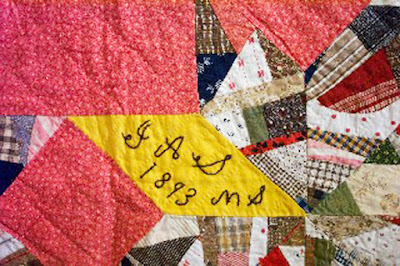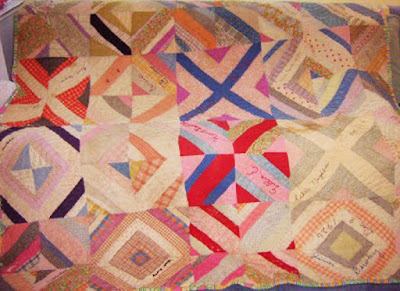"School of Design
Engraving Class
Cooper Union"
When I read the inscription on this sampler quilt I knew what it meant. I'd done a little research on quilts made in the Cooper Union building in New York City during the Civil War. I realized this is likely a rare Civil War survivor---a quilt made there to donate to the Union Sanitary Commission.
Peter Cooper (1791-1883) with a granddaughter
The Cooper Union was (and is) an art school in New York City. Wealthy entrepreneur Peter Cooper founded The Cooper Union for the Advancement of Science and Art in 1859. The beautiful building housed offices, classrooms and studios and a Great Hall seating almost a thousand people in one of the city's tallest structures at the time.
The Cooper Union building about 1890
Cooper's liberal ideas included a free education not only for talented men but for women. Once accepted students paid no tuition. “To better the condition of woman and to widen the sphere of female employment I have provided seven rooms to be forever devoted to a Female School of Design.” The Engraving Class prepared art students for a career in commercial art. One acceptable female occupation was wood engraving, the process widely used to illustrate publications.
Wood engraving picturing students learning wood engraving at the
Cooper Union, 1883
They drew and cut images on the end of blocks of boxwood.
Small hands, acute near vision, a talent for drawing, and attention to detail
were qualifications that made it a good job for young women.
The Engraving Room was in a well-lit studio...
Probably on the fourth floor on the side behind those Gothic arched windows
The inscription is beautifully embroidered in blue thread.
Sarah Bedell Cooper (1793-1869)
The Association's offices were on the ground floor of the building. In this Civil-War-era
photo men address crates of donated hospital supplies to be sent to
Sanitary Commission agents in the field.
The quilt is 54" wide by 88".
Sanitary Commission guidelines asked for
long, narrow quilts to fit hospital beds.
The New York organization alone reported that in its first two and a half years
they received 20,444 quilts to distribute to hospitals.
The war dragged on for over another year.
Engraving by Guilielma's student Alice Donlevy
"Under her guidance many patchwork quilts were made during the Civil War, in an upper room in the Cooper Institute, where the students of the Art School came to quilt for any half hour they could spare after lesson times....Every student that I remember had to learn to quilt."
Skylights on the top floor may have provided light for quilting.
Alice also recalled that Gulielma opened "the every day quilting bee with poetry" and she was a "diplomatic teacher."
"One of her warmest admirers was a young Southern girl. Gulielma would cut off her criticisms of President Lincoln with a question about books, and succeeded in keeping the atmosphere of that quilting bee restfully sympathetic."
The blocks are well-pieced. Gulielma must have been
an exacting teacher in quilting as well as engraving.
I'd guess you pronounce her name Julie-Elma.
The products of the Engraving Department's restful quilting bee went to the Sanitary Commission offices on the first floor. My new quilt must have been one of many stitched at the Cooper Union.
More about this quilt tomorrow.
http://civilwarquilts.blogspot.com/2016/12/stitching-soldiers-quilts-at-cooper.html
Read Donlevy's biography of her teacher Gulielma here:
https://books.google.com/books?id=aILTAAAAMAAJ&pg=PA452&dq=gulielma+field+cooper&hl=en&sa=X&ved=0ahUKEwjNgrz1pK_iAhUGSa0KHRE4BSgQ6AEIKjAA#v=onepage&q=gulielma%20field%20cooper&f=false



































































